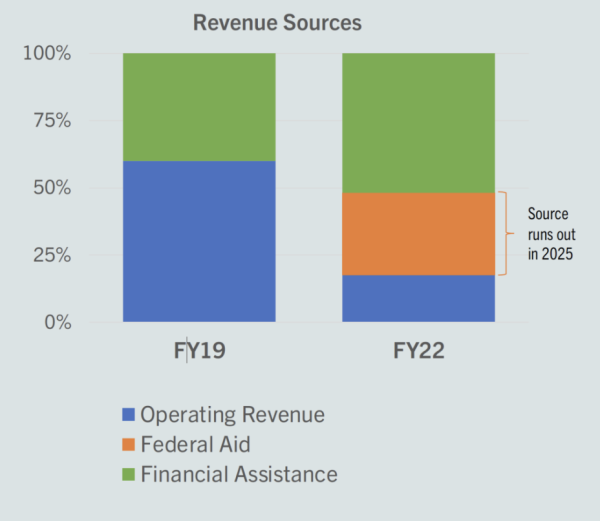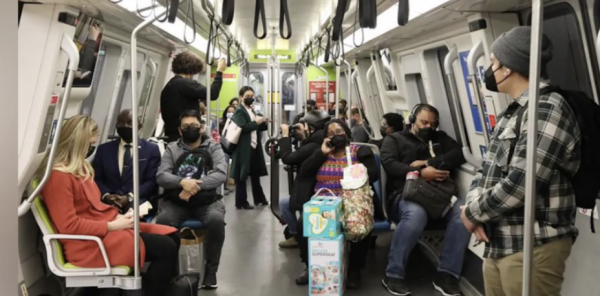BART, or Bay Area Rapid Transit, is a backbone of the Bay Area as it provides a rapid and efficient means of commuting for residents and visitors. By helping reduce traffic congestion and promoting sustainability through its overall accessibility, this public transit system has been recognized as a “nationwide model of self-sufficiency”. However, things changed for the worse when the pandemic struck in 2019.
Prior to the Covid-19 outbreak, fares accounted for 86% of BART’s total operating venue, which covered over 61% of its operational expenses. This statistic plummeted to just 17% of operational expenses covered through fares in 2022. The annual $300 million structural deficit that BART is currently facing exposes serious problems in maintaining sustainable funding, which is why the need for long-term financial planning has to take precedence in order to ensure a sense of public reliability.
You may ask why people aren’t returning to BART, as it had a large amount of passengers before the pandemic and hasn’t experienced problems before. The emergence of a work-at-home culture after the pandemic has reduced the need for transport, causing a decrease in passengers across all transport modes.
However, a BART Survey taken in May exposes a more shocking problem: asking what is actually keeping passengers from riding BART. More than 78% of respondents said that they would ride BART more often if it had a cleaner and safer environment, with only 17% saying they felt safe on BART.
Bay Area Council CEO Jim Wunderman shares that “People are hesitating to get on board because they have fear […] They don’t want to experience these conditions”. Since then, BART has made more officers patrol its trains, but that has just added more to their growing deficit.

BART has had significant financial aid since the end of the pandemic, with it receiving 1.6 billion dollars in federal funding, and around 45% of the $781 million allocated to transit agencies going to limit BART’s operating deficit. However, its debt and losses are still accumulating each year, with the prediction being that it will run out of funding in 2025.
Unfortunately, it seems that BART is still operating as if nothing has changed. “When ridership drops as it has dramatically, and that farebox revenue is not coming in, you have to make the adjustments to ensure your system is running efficiently and appropriately under the circumstances in which you find yourself and BART didn’t do that,” said State Senator Steve Glazer.
But, there are certain financial stability strategies that BART can use to its advantage in an effort to cover up their structural deficit. Offering frequent, reliable, and safe service, as well as reducing the amount of canceled trips will temporarily alleviate the crisis by maximizing fare revenue and enhancing customer satisfaction.
If consistent funding is not secured, BART will undoubtedly face devastating cuts that are too precipitous to account for. This is a significant issue as the overall prosperity and livability, especially for those who live in under-developed communities and rely heavily on public transportation, will be depleted. ABC7 News predicts that some potential consequences of BART’s funding falling may include mass layoffs, station closures, increased traffic, and a negative impact on the climate.

(BART relying on one-time emergency funds)
The future’s looking grim for BART as the consistent funding referenced earlier doesn’t seem like it’s coming. Governor Newsom in his state budget proposal didn’t mention the $5 billion they’ll need to keep BART and other state transit agencies—who are also declining—running. Newsom, in fact, is proposing to cut the budget for transit and other climate efforts as California itself is in a deficit, stating that “We’re just not in a position to solve for their short-term needs at the moment”.
Public transportation in California as a whole is looking bleak, as the same decline in riders affecting BART is being experienced by other transit companies around the Bay Area. Taking public transportation reduces greenhouse gas emissions by almost 50%, an undeniably better alternative to vehicles on the road—which releases an average of a pound of CO2 per mile.
The decline of public transit, like BART, constrains the number of options for accessible, efficient transportation. As a result, it is likely that there will be a significantly increased number of cars on the road leading to traffic congestion, and increased parking requirements for buildings. Even worse, for families that don’t have a personal vehicle, they would be forced to walk or use other roundabout methods to get to their destination.

This dilemma between fixing the state debt and investing money into severe weather protections versus putting aside money to bail out public transport undeniably affects the average citizen and student. There is no simple solution to BART’s impending catastrophe, and getting the “cash flow on track” is easier said than done, but swift change to pull these transit companies out of their death spiral, and the passage of supporting laws could help ease the situation.
Behind all data lies the lives of many Californians with limited transportation options, and the life of our climate, which is why one should gauge the derailment of BART as a transit system.


